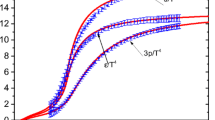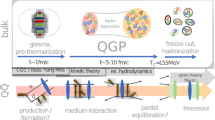Abstract
We present a strangeness-neutral equation of state for QCD that exhibits critical behavior and matches lattice QCD results for the Taylor-expanded thermodynamic variables up to fourth order in \(\mu _B/T\). It is compatible with the SMASH hadronic transport approach and has a range of temperatures and baryonic chemical potentials relevant for phase II of the Beam Energy Scan at RHIC. We provide an updated version of the software BES-EoS, which produces an equation of state for QCD that includes a critical point in the 3D Ising model universality class. This new version also includes isentropic trajectories and the critical contribution to the correlation length. Since heavy-ion collisions have zero global net-strangeness density and a fixed ratio of electric charge to baryon number, the BES-EoS is more suitable to describe this system. Comparison with the previous version of the EoS is thoroughly discussed.










Similar content being viewed by others
Notes
As in Ref. [46], we assume the transition line to be a parabola and utilize the curvature parameter \(\kappa =-0.0149\) from Ref. [4]. Recent results from lattice QCD [33, 58] are consistent with this value and predict the next to leading order parameter \(\kappa _4\) to be consistent with 0 within errors.
References
Y. Aoki, G. Endrodi, Z. Fodor, S.D. Katz, K.K. Szabo, Nature 443, 675 (2006). https://doi.org/10.1038/nature05120. arXiv:hep-lat/0611014 [hep-lat]
S. Borsanyi, Z. Fodor, C. Hoelbling, S.D. Katz, S. Krieg, C. Ratti, K.K. Szabo (collaboration Wuppertal-Budapest), JHEP 09, 073 (2010). https://doi.org/10.1007/JHEP09(2010)073, arXiv:1005.3508 [hep-lat]
G. Endrodi, Z. Fodor, S.D. Katz, K.K. Szabo, JHEP 04, 001 (2011). https://doi.org/10.1007/JHEP04(2011)001. arXiv:1102.1356 [hep-lat]
R. Bellwied, S. Borsanyi, Z. Fodor, J. Günther, S.D. Katz, C. Ratti, K.K. Szabo, Phys. Lett. B 751, 559 (2015). https://doi.org/10.1016/j.physletb.2015.11.011. arXiv:1507.07510 [hep-lat]
J.N. Guenther (2020), arXiv:2010.15503 [hep-lat]
M. Stephanov, Phys. Rev. Lett. 107, 052301 (2011). https://doi.org/10.1103/PhysRevLett.107.052301. arXiv:1104.1627 [hep-ph]
C. Ratti, M.A. Thaler, W. Weise (2006), arXiv:nucl-th/0604025
R. Critelli, J. Noronha, J. Noronha-Hostler, I. Portillo, C. Ratti, R. Rougemont, Phys. Rev. D 96 (2017). https://doi.org/10.1103/PhysRevD.96.096026, arXiv:1706.00455 [nucl-th]
C. Ratti, Rep. Prog. Phys. 81, 096026 (2018). https://doi.org/10.1088/1361-6633/aabb97. arXiv:1804.07810 [hep-lat]
A. Bzdak, S. Esumi, V. Koch, J. Liao, M. Stephanov, N. Xu, Phys. Rep. 853, 1 (2020). https://doi.org/10.1016/j.physrep.2020.01.005. arXiv:1906.00936 [nucl-th]
V. Dexheimer, J. Noronha, J. Noronha-Hostler, C. Ratti, N. Yunes (2020), arXiv:2010.08834 [nucl-th]
A. Monnai, B. Schenke, C. Shen (2021), arXiv:2101.11591 [nucl-th]
S. Borsanyi, G. Endrodi, Z. Fodor, A. Jakovac, S.D. Katz, S. Krieg, C. Ratti, K.K. Szabo, JHEP 11, 077 (2010). https://doi.org/10.1007/JHEP11(2010)077. arXiv:1007.2580 [hep-lat]
S. Borsanyi, Z. Fodor, C. Hoelbling, S.D. Katz, S. Krieg, K.K. Szabo, Phys. Lett. B 730, 99 (2014). https://doi.org/10.1016/j.physletb.2014.01.007. arXiv:1309.5258 [hep-lat]
A. Bazavov et al. (collaboration HotQCD) Phys. Rev. D 90 (2014). https://doi.org/10.1103/PhysRevD.90.094503arXiv:1407.6387 [hep-lat]
S. Borsanyi, G. Endrodi, Z. Fodor, S.D. Katz, S. Krieg, C. Ratti, K.K. Szabo, JHEP 08, 053 (2012). https://doi.org/10.1007/JHEP08(2012)053. arXiv:1204.6710 [hep-lat]
A. Bazavov et al., Phys. Rev. D 95, 054504 (2017). https://doi.org/10.1103/PhysRevD.95.054504. arXiv:1701.04325 [hep-lat]
J. Gunther, R. Bellwied, S. Borsanyi, Z. Fodor, S.D. Katz, A. Pasztor, C. Ratti, in Proceedings, 12th Conference on Quark Confinement and the Hadron Spectrum (Confinement XII): Thessaloniki, Greece, EPJ Web Conference 137, 07008 (2017). https://doi.org/10.1051/epjconf/201713707008arXiv:1607.02493 [hep-lat]
R. Bellwied, S. Borsanyi, Z. Fodor, S. Katz, A. Pasztor, C. Ratti, K. Szabo, Phys. Rev. D 92, 114505 (2015). https://doi.org/10.1103/PhysRevD.92.114505. arXiv:1507.04627 [hep-lat]
J. Günther, R. Bellwied, S. Borsanyi, Z. Fodor, S.D. Katz, A. Pasztor, C. Ratti, EPJ Web Conf. 137, 07008 (2017). https://doi.org/10.1051/epjconf/201713707008
S. Borsanyi, Z. Fodor, J.N. Guenther, S.K. Katz, K.K. Szabo, A. Pasztor, I. Portillo, C. Ratti, JHEP 10, 205 (2018). https://doi.org/10.1007/JHEP10(2018)205. arXiv:1805.04445 [hep-lat]
A. Bazavov et al., Phys. Rev. D 101, 074502 (2020). https://doi.org/10.1103/PhysRevD.101.074502. arXiv:2001.08530 [hep-lat]
S. Borsányi, Z. Fodor, J.N. Guenther, R. Kara, S.D. Katz, P. Parotto, A. Pásztor, C. Ratti, K.K. Szabó (2021), arXiv:2102.06660 [hep-lat]
J. Noronha-Hostler, P. Parotto, C. Ratti, J.M. Stafford, Phys. Rev. C 100, 064910 (2019). https://doi.org/10.1103/PhysRevC.100.064910. arXiv:1902.06723 [hep-ph]
A. Monnai, B. Schenke, C. Shen, Phys. Rev. C 100, 024907 (2019). https://doi.org/10.1103/PhysRevC.100.024907. arXiv:1902.05095 [nucl-th]
M. D’Elia, G. Gagliardi, F. Sanfilippo, Phys. Rev. D 95, 094503 (2017). https://doi.org/10.1103/PhysRevD.95.094503. arXiv:1611.08285 [hep-lat]
S. Borsányi, Z. Fodor, M. Giordano, S.D. Katz, A. Pasztor, C. Ratti, A. Schäfer, K.K. Szabo, B.C. Tóth, Phys. Rev. D 98, 014512 (2018). https://doi.org/10.1103/PhysRevD.98.014512. arXiv:1802.07718 [hep-lat]
M. Giordano, K. Kapas, S.D. Katz, D. Nogradi, A. Pasztor, JHEP 05, 088 (2020). https://doi.org/10.1007/JHEP05(2020)088. arXiv:2004.10800 [hep-lat]
Z. Fodor, S.D. Katz, JHEP 04, 050 (2004). https://doi.org/10.1088/1126-6708/2004/04/050. arXiv:hep-lat/0402006
S. Datta, R.V. Gavai, S. Gupta, Phys. Rev. D 95, 054512 (2017). https://doi.org/10.1103/PhysRevD.95.054512. arXiv:1612.06673 [hep-lat]
C.S. Fischer, J. Luecker, Phys. Lett. B 718, 1036 (2013). https://doi.org/10.1016/j.physletb.2012.11.054. arXiv:1206.5191 [hep-ph]
G. Eichmann, C.S. Fischer, C.A. Welzbacher, Phys. Rev. D 93, 034013 (2016). https://doi.org/10.1103/PhysRevD.93.034013. arXiv:1509.02082 [hep-ph]
S. Borsanyi, Z. Fodor, J.N. Guenther, R. Kara, S.D. Katz, P. Parotto, A. Pasztor, C. Ratti, K.K. Szabo, Phys. Rev. Lett. 125, 052001 (2020). https://doi.org/10.1103/PhysRevLett.125.052001. arXiv:2002.02821 [hep-lat]
W.-J. Fu, J.M. Pawlowski, F. Rennecke, Phys. Rev. D 101, 054032 (2020). https://doi.org/10.1103/PhysRevD.101.054032. arXiv:1909.02991 [hep-ph]
F. Gao, J.M. Pawlowski (2020), arXiv:2010.13705 [hep-ph]
X. An, G. Başar, M. Stephanov, H.-U. Yee (2020), arXiv:2009.10742 [hep-th]
D. Mroczek, J. Noronha-Hostler, A.R.N. Acuna, C. Ratti, P. Parotto, M.A. Stephanov, Phys. Rev. C 103, 034901 (2021). https://doi.org/10.1103/PhysRevC.103.034901. arXiv:2008.04022 [nucl-th]
M. Bluhm et al., Nucl. Phys. A 1003, 122016 (2020). https://doi.org/10.1016/j.nuclphysa.2020.122016. arXiv:2001.08831 [nucl-th]
M. Nahrgang, M. Bluhm, Phys. Rev. D 102, 094017 (2020). https://doi.org/10.1103/PhysRevD.102.094017. arXiv:2007.10371 [nucl-th]
M. Nahrgang, M. Bluhm, T. Schaefer, S.A. Bass, Phys. Rev. D 99, 116015 (2019). https://doi.org/10.1103/PhysRevD.99.116015. arXiv:1804.05728 [nucl-th]
A. Sorensen, V. Koch (2020), arXiv:2011.06635 [nucl-th]
J. Grefa, J. Noronha, J. Noronha-Hostler, I. Portillo, C. Ratti, R. Rougemont (2021), arXiv:2102.12042 [nucl-th]
A. Motornenko, J. Steinheimer, V. Vovchenko, S. Schramm, H. Stoecker, Phys. Rev. C 101, 034904 (2020). https://doi.org/10.1103/PhysRevC.101.034904. arXiv:1905.00866 [hep-ph]
V. Vovchenko, J. Steinheimer, O. Philipsen, H. Stoecker, Phys. Rev. D 97, 114030 (2018). https://doi.org/10.1103/PhysRevD.97.114030. arXiv:1711.01261 [hep-ph]
V. Vovchenko, J. Steinheimer, O. Philipsen, A. Pasztor, Z. Fodor, S.D. Katz, H. Stoecker, Nucl. Phys. A 982, 859 (2019). https://doi.org/10.1016/j.nuclphysa.2018.10.068. arXiv:1807.06472 [hep-lat]
P. Parotto, M. Bluhm, D. Mroczek, M. Nahrgang, J. Noronha-Hostler, K. Rajagopal, C. Ratti, T. Schäfer, M. Stephanov, Phys. Rev. C 101, 034901 (2020). https://doi.org/10.1103/PhysRevC.101.034901. arXiv:1805.05249 [hep-ph]
T. Dore, J. Noronha-Hostler, E. McLaughlin, Phys. Rev. D 102, 074017 (2020). https://doi.org/10.1103/PhysRevD.102.074017. arXiv:2007.15083 [nucl-th]
Y. Hama, T. Kodama, W.-L. Qian, J. Phys. G 48, 015104 (2021). https://doi.org/10.1088/1361-6471/abb44a. arXiv:2010.08716 [nucl-th]
E. McLaughlin, J. Rose, T. Dore, P. Parotto, C. Ratti, J. Noronha-Hostler (2021), arXiv:2103.02090 [nucl-th]
H. Petersen, D. Oliinychenko, M. Mayer, J. Staudenmaier, S. Ryu, Nucl. Phys. A 982, 399 (2019). https://doi.org/10.1016/j.nuclphysa.2018.08.008. arXiv:1808.06832 [nucl-th]
K. Fukushima, Phys. Rev. D 79, 074015 (2009). https://doi.org/10.1103/PhysRevD.79.074015. arXiv:0901.0783 [hep-ph]
W.-J. Fu, J.M. Pawlowski, F. Rennecke, SciPost Phys. Core 2, 002 (2020). https://doi.org/10.21468/SciPostPhysCore.2.1.002. arXiv:1808.00410 [hep-ph]
The code on which this work is based can be downloaded at, https://www.bnl.gov/physics/best/resources.php
R.D. Pisarski, F. Wilczek, Phys. Rev. D 29, 338 (1984). https://doi.org/10.1103/PhysRevD.29.338
K. Rajagopal, F. Wilczek, Nucl. Phys. B 399, 395 (1993). https://doi.org/10.1016/0550-3213(93)90502-G. arXiv:hep-ph/9210253
R. Guida, J. Zinn-Justin, Nucl. Phys. B 489, 626 (1997). https://doi.org/10.1016/S0550-3213(96)00704-3. arXiv:hep-th/9610223
C. Nonaka, M. Asakawa, Phys. Rev. C 71, 044904 (2005). https://doi.org/10.1103/PhysRevC.71.044904. arXiv:nucl-th/0410078
A. Bazavov et al. (collaboration HotQCD), Phys. Lett. B 795, 15 (2019). https://doi.org/10.1016/j.physletb.2019.05.013arXiv:1812.08235 [hep-lat]
P. Alba et al., Phys. Rev. D 96, 034517 (2017). https://doi.org/10.1103/PhysRevD.96.034517. arXiv:1702.01113 [hep-lat]
A. Monnai, S. Mukherjee, Y. Yin, Phys. Rev. C 95, 034902 (2017). https://doi.org/10.1103/PhysRevC.95.034902. arXiv:1606.00771 [nucl-th]
E. Brezin, J. Le Guillou, J. Zinn-Justin, in Phase Transitions and Critical Phenomena
B. Berdnikov, K. Rajagopal, Phys. Rev. D 61, 105017 (2000). https://doi.org/10.1103/PhysRevD.61.105017. arXiv:hep-ph/9912274
J. Weil et al., Phys. Rev. C 94, 054905 (2016). https://doi.org/10.1103/PhysRevC.94.054905. arXiv:1606.06642 [nucl-th]
Acknowledgements
The authors would like to thank Volker Koch, Volodymyr Vovchenko, and Travis Dore for fruitful discussion. We would also like to thank Hannah Elfner, Anna Schäfer, and Dmytro Oliinychenko for their assistance in obtaining the hadronic list from SMASH. Furthermore, we would like to acknowledge our fellow BEST collaboration members for helping motivate this work at the previous collaboration meeting. This material is based upon work supported by the National Science Foundation under Grant No. PHY1654219, the US-DOE Nuclear Science Grant No. DE-SC0020633, the National Science Foundation Graduate Research Fellowship Program under Grant No. DGE-1746047, and by the U.S. Department of Energy, Office of Science, Office of Nuclear Physics, within the framework of the Beam Energy Scan Topical (BEST) Collaboration. We also acknowledge the support from the Center of Advanced Computing and Data Systems at the University of Houston. P.P. acknowledges support by the DFG Grant SFB/TR55.
Author information
Authors and Affiliations
Corresponding author
Appendix A: smooth merging of correlation length
Appendix A: smooth merging of correlation length
In order to obtain a result for the correlation length that is consistent with the scaling behavior of the 3D Ising model, we perform a smooth merging of the \(\epsilon \)-expansion and asymptotic forms of the correlation length, as shown in Eqs. (14), (15). We employ a hyperbolic tangent in order to achieve a well-behaved result, useful for hydrodynamic simulations:
where \(T'(\mu _B)\) acts as the switching temperature and \(\Delta T(\mu _B)\) is the overlap region between the two representations. The merging is performed along a curve in the \((T,\mu _B)\) plane that corresponds to a value of the scaling parameter \(x=5\), as stated in Sect. 4. The shape which this curve follows in the QCD phase diagram is shown in Fig. 11. Since this is a multi-valued function of \(\mu _B\), in order to fit this curve for the switching temperature, we separate it into two functions \(T_{\text {low}}'(\mu _B)\) and \(T_{\text {high}}'(\mu _B)\) for different temperature regimes. These curves were best fit with exponentials, the functional forms for which are
where \(T_{\text {M,low}}=195\) MeV, \(T_{0,\text {low}}=58\) MeV, \(k_{\text {low}}=0.00318462\), \(T_{0,\text {high}}=282.594\) MeV, \(k_{\text {high}}=0.00207197\). We additionally write the overlap region, \(\Delta T\), as a function of \(\mu _B\) in order to achieve the smoothest possible result for the correlation length. For this function, we also employ an exponential:
where \(T_{\text {M,merg}}=17\) MeV, \(T_{0,\text {merg}}=0.1\) MeV, \(k_{\text {merg}}=0.0075\). This procedure for the smooth merging of the two representations of the correlation length through a hyperbolic tangent yields the critical contribution to the correlation length shown in Fig. 6.
Rights and permissions
About this article
Cite this article
Karthein, J.M., Mroczek, D., Nava Acuna, A.R. et al. Strangeness-neutral equation of state for QCD with a critical point. Eur. Phys. J. Plus 136, 621 (2021). https://doi.org/10.1140/epjp/s13360-021-01615-5
Received:
Accepted:
Published:
DOI: https://doi.org/10.1140/epjp/s13360-021-01615-5





